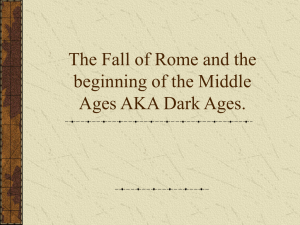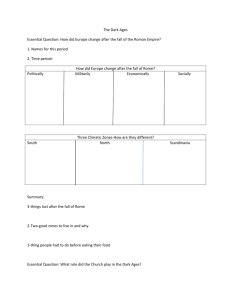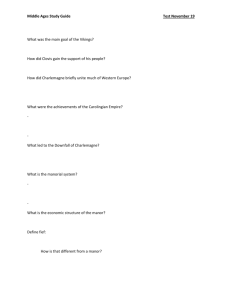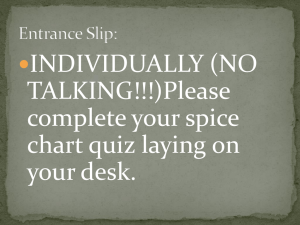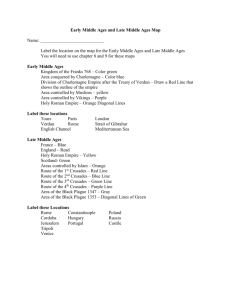Fall of Rome - World of Teaching
advertisement
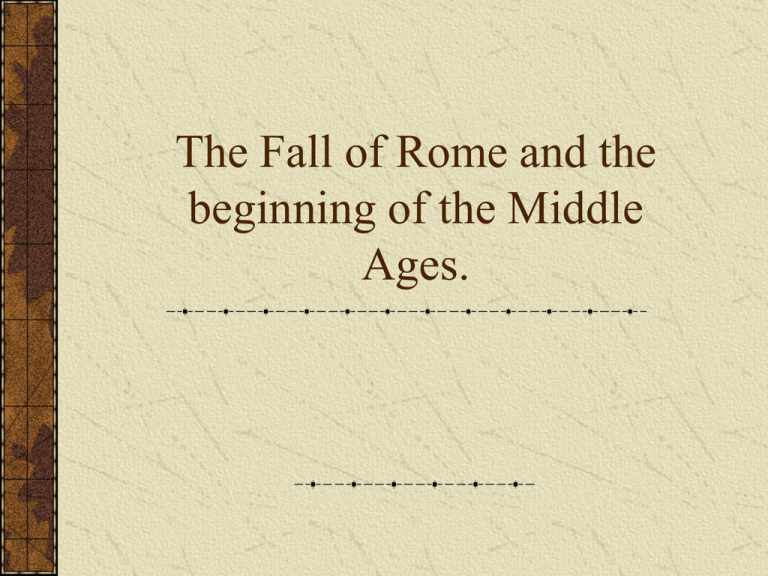
The Fall of Rome and the beginning of the Middle Ages. Fall of the Roman Empire Rome was the most powerful empire the world had ever seen. Its architecture was Hellenistic and its road system was as impressive as that of the Inca in S. America Roman Empire at its height 117 C.E. Roman legal accomplishments Rome had a republican democracy sometimes Rome had a senate where patricians could represent people Rule of Law It means nobody is above the law, not the king, not the senate, not the people, not the police. Laws are written down and must be respected Rule of Law!! Three other examples Disease led to its Fall "Realizing what a deadly disaster had come to them, the people quickly drove the Italians from their city. But the disease remained, and soon death was everywhere. Fathers abandoned their sick sons. Lawyers refused to come and make out wills for the dying. Friars and nuns were left to care for the sick, and monasteries and convents were soon deserted, as they were stricken, too. Bodies were left in empty houses, and there was no one to give them a Christian burial." Bubonic plague “Black plague” It was called the black plague because of the dark spots found on its victims Coffins were rare, most were buried in mass graves! Why was Rome so affected by the Plague? Fall of Rome Rome was besieged by various tribes from modern day Germany and France. Although the fall of the Roman Empire did not happen overnight, many consider its fall the beginning of the Middle Ages or Dark Ages. Major Eras of European History Classical Era (Greece and Rome) 500 B.C.- 600 A.D. Middle Ages (time of knights and castles) 500 A.D. – 1500 A.D. Early Modern Era (time of powerful kings and exploration) 1500 A.D. – 1776 A.D. Knights! Castles! Feudal Warfare!!!! Trebuchets were used to hurl all sorts of objects at the enemy. The Middle Ages were a dangerous time in Europe The strong empires of Rome and Greece that protected trade routes and encouraged science and personal liberties were fading away. The Roman empire not only had to fight the plague but fight invaders from Europe and Asia. Genghis Kahn Mongolian warrior Vikings! No more large cities, trade, scholarship. With all the disease, riots, outside attacks and starvation people fled the cities of the once strong Roman empire. In Europe, people now lived on manors, self-sufficient communities consisting of a castle, church, village and surrounding farmlands. Manoralism (econ. system) or safety and for defense, people in the Middle Ages formed small communities around a central lord or master. Most people lived on a manor, which consisted of the castle, the church, the village, and the surrounding farm land. These manors were isolated, with occasional visits from peddlers, pilgrims on their way to the Crusades, or soldiers from other fiefdoms. Why do you think everyone chose to be isolated? Feudalism (political system) The kings had lots of land; he gave land to lords in exchange for protection and $. Lords gave their land to knights in exchange for protection, $. Knights let serfs work the land and he would protect them. Serfs got food and shelter. Thus, each person had rights and responsibilities Chivalry- code of honor Magna Carta Signed in 1215 Example of Rule of Law English King John was a bad king so his nobles forced him to sign it. Limited powers of king. There are 2 wars you need to know about. In 1066, England was invaded by Normans (Vikings from modern-day France) and conquered all of England William of Normandy helped make England what it is today and codified feudalism (gave it the force of law). Crusades The Crusades were a series of battles between Christians and Muslims in the Middle East. Christian knights wanted to take the Holy Land and give it back to Christians Why was Constantinople so important geographically? Crusades Thousands of knights and “barbarian” soldiers united under Christianity attacked Muslims and Jews in Turkey and Jerusalem to gain the land for Christians. The Arab world was relatively peaceful and civilized at the time. An Arab gentleman was expected to be a poet and philosopher as well as a warrior. They had correctly calculated the distance from earth to the moon. And one Arab had even suggested that if he could split the atom, it would release enough power to destroy a city the size of Baghdad. Furthermore, Jerusalem itself was a multicultural city. Jews, Moslems and Christians all lived together harmoniously. Christians on pilgrimages to Jerusalem were freely allowed across to the Holy Places When the Crusades arrived in Northern Turkey, the carnage began. The town of Lycea was captured and looted. Reports told of babies cut to pieces. Old people were subjected to every kind of torture. Unfortunately, most of the inhabitants of Lycea were actually Christians… Impact of the Crusades Persecution of Jews and Muslims Economic development via trade Kings and popes, gained power as a result. Role of Church in Middle Ages Never was there a time when the Church was so powerful in Western Civilization. The Church was led by popes. Priests and nuns converted, gave care to people Role of Church Monks were spiritual leaders (obviously) They lived in monasteries that acted like trade schools and YMCAs Role of Church They spent years transcribing the Bible since the printing press wasn’t used in Europe yet. Churches and Cathedrals during the Middle Ages Role of Church Since there were no strong empires or kingdoms the Church was one organization that had respect and power. Popes were more powerful than kings! Important Middle Ages Technologies Water Wheel Eyeglasses Mechanical Clock Printing Gunpowder Eyeglasses Invented in Pisa 13th century By 15th century Italy making thousands spectacles Eyeglasses encouraged invention of fine instruments Gauges Micrometers Fine wheel cutters Precision tools Mechanical Clock Undermined Church authority equal hours for day and night a new concept Resisted by the church for a century Every town wanted one Public clocks installed in towers Conquerors seized as spoils of war Allowed individual autonomy Work now measured by time increased productivity Bern, Switzerland Gunpowder Europeans improved gunpowder to siege castles Europeans focused on range and weight of projectiles: siege warfare With improved metal casting, made world’s best cannon Summary The Roman Empire fell due to outside attacks and disease (brought on by trade) The Middle Ages began as the Church replaced governments as the central authority. Feudalism/ Manoralism came from people’s need for protection. Each member had rights and responsibilities. Cultures interact through wars, such as the Crusades, and trade ideas such as democratic ideas or religious ideas Any questions before the quiz? 1. What 2 reasons did the Roman empire cease to be a powerful empire? 2. Name 2 examples of Rule of Law 3. What was the economic system of the Middle Ages in Europe? 4. Under Feudalism, what responsibility does a knight have? What does he give in return? 5.In what year did William of Normandy invade England? 6. What were the Crusades? 7. What era (time period) describes the time of Greece and Rome? 8. What year was the Magna Carta signed? This powerpoint was kindly donated to www.worldofteaching.com http://www.worldofteaching.com is home to over a thousand powerpoints submitted by teachers. This is a completely free site and requires no registration. Please visit and I hope it will help in your teaching.


